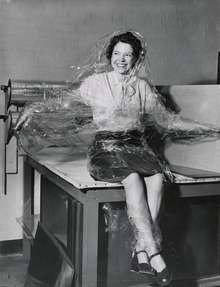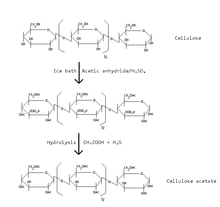Cellulose acetate

Cellulose acetate is the acetate ester of cellulose. It was first prepared in 1865. Cellulose acetate is used as a film base in photography, as a component in some coatings, and as a frame material for eyeglasses;[1] it is also used as a synthetic fiber in the manufacture of cigarette filters and playing cards. In photographic film, cellulose acetate replaced nitrate film in the 1950s, being far less flammable and cheaper to produce.
History

In 1865, Paul Schützenberger discovered that cellulose reacts with acetic anhydride to form cellulose acetate. The German chemists Arthur Eichengrün and Theodore Becker invented the first soluble forms of cellulose acetate in 1903.[2]
In 1904, Camille Dreyfus and his younger brother Henri performed chemical research and development on cellulose acetate in a shed in their father's garden in Basel, Switzerland, which was then a center of the dye industry. For five years, the Dreyfus brothers studied and experimented in a systematic manner in Switzerland and France. By 1910, they were producing film for the motion picture industry, and a small but constantly growing amount of acetate lacquer, called "dope", was sold to the expanding aircraft industry to coat the fabric covering wings and fuselage.[3]
In 1913, after some twenty thousand separate experiments, they produced excellent laboratory samples of continuous filament yarn, something that had eluded the cellulose acetate industry to this time.[3] Unfortunately the outbreak of World War I postponed commercial development of this process.
In November 1914, the British Government invited Dr. Camille Dreyfus to come to England to manufacture acetate dope, and the "British Cellulose and Chemical Manufacturing Co" was set up. In 1917, after the United States had entered the war, the U.S. War Department invited Dr. Dreyfus to establish a similar factory in the US. Both operations were run successfully throughout the war.
After the war, attention returned to the production of acetate fibers. The first yarn was of fair quality, but sales resistance was heavy, and silk associates worked zealously to discredit acetate and discourage its use. However, the thermoplastic nature of acetate made it an excellent fiber for moiré, because the pattern was permanent and did not wash away. The same characteristic also made permanent pleating a commercial fact for the first time, and gave great style impetus to the whole dress industry.[3]
The mixing of silk and acetate in fabrics was accomplished at the beginning and almost at once cotton was also blended, thus making possible low-cost fabrics by means of a fiber which then was cheaper than silk or acetate. Today, acetate is blended with silk, cotton, wool, nylon, etc. to give fabrics excellent wrinkle recovery, good left, handle, draping quality, quick drying, proper dimensional stability, cross-dye pattern potential, at a very competitive price.[3]
Acetate fiber and triacetate fiber
Cellulose acetate and cellulose triacetate are mistakenly referred to as the same fiber; although they are similar, their chemical compositions and formulae differ. Triacetate is known as a generic description or primary acetate containing no hydroxyl group. Acetate fiber is known as modified or secondary acetate having two or more hydroxyl groups. Triacetate fibers, although no longer produced in the United States, contain a higher ratio of acetate-to-cellulose than do acetate fibers.[1]
Film
Cellulose acetate film was introduced in 1934 as a replacement for the cellulose nitrate film stock that had previously been standard. When exposed to heat or moisture, acids in the film base begin to deteriorate to an unusable state, releasing acetic acid with a characteristic vinegary smell, causing the process to be known as "vinegar syndrome." Acetate film stock is still used in some applications, such as camera negative for motion pictures. Since the 1980s, polyester film stock (sometimes referred to under Kodak's trade name "ESTAR Base") has become more commonplace, particularly for archival applications. Acetate film was also used as the base for magnetic tape, prior to the advent of polyester film.
Magnetic tape
Cellulose acetate magnetic tape was introduced by IBM in 1952 for use on their IBM 726 tape drive in the IBM 701 computer. It was much lighter and easier to handle than the metal tape introduced by UNIVAC in 1951 for use on their UNISERVO tape drive in the UNIVAC I computer. In 1956 cellulose acetate magnetic tape was replaced by the more stable PET film magnetic tape for use on their IBM 727 tape drive.
Fiber
Cellulose acetate fiber is one of the earliest synthetic fibers and is based on cotton or tree pulp cellulose ("biopolymers"). These "cellulosic fibers" have been replaced in many applications by cheaper petro-based fibers (nylon and polyester) in recent decades.[4]
Trade names for acetate include Acele, Avisco, Celanese, Chromspun and Estron.[5]
Acetate shares many similarities with rayon, and was formerly considered as the same textile. Acetate differs from rayon in the employment of acetic acid in production. The two fabrics are now required to be listed distinctly on garment labels.[6]
Rayon resists heat while acetate is prone to melting. Acetate must be laundered with care either by hand-washing or dry cleaning. Acetate garments will disintegrate when heated in a tumble dryer.[7][8]
The breathable nature of the fabric suits it for use as a lining. Acetate fabric is used frequently in wedding gowns and other bridal attire. [9] Its lustrous sheen and smooth, satiny texture make it a good synthetic alternative to silk.[7]
Fiber properties
Acetate is a very valuable manufactured fiber that is low in cost and has good draping qualities. Acetate is used in fabrics such as satins, brocades, and taffetas to accentuate luster, body, drape and beauty.
- Hand: soft, smooth, dry, crisp, resilient
- Comfort: breathes, wicks, dries quickly, no static cling
- Drape: linings move with the body linings conform to the garment
- Color: deep brilliant shades with atmospheric dyeing meet colorfastness requirements
- Luster: light reflection creates a signature appearance
- Performance: colorfast to perspiration staining, colorfast to dry cleaning, air and vapor permeable
- Tenacity: weak fiber with breaking tenacity of 1.2 to 1.4 g/d; rapidly loses strength when wet; must be dry cleaned
- Abrasion: poor resistance
- Heat retention: poor thermal retention; no allergenic potential (hypoallergenic)
- Dyeability: (two methods) cross-dying method where yarns of one fiber and those of another fiber are woven into a fabric in a desired pattern; solution-dying method provides excellent color fastness under the effects of sunlight, perspiration, air contaminants and washing[1][10]
Production

The Federal Trade Commission definition for acetate fiber is "A manufactured fiber in which the fiber-forming substance is cellulose acetate. Where not less than 92 percent of the hydroxyl groups are acetylated, the term triacetate may be used as a generic description of the fiber."
Acetate is derived from cellulose by deconstructing wood pulp into a purified fluffy white cellulose. In order to get a good product, special qualities of pulps - dissolving pulps - are used. A common problem with these is that the reactivity of the cellulose is uneven, and the quality of the cellulose acetate will sometimes be impacted. The cellulose is then reacted with acetic acid and acetic anhydride in the presence of sulfuric acid. It is then put through a controlled, partial hydrolysis to remove the sulfate and a sufficient number of acetate groups to give the product the desired properties. The anhydroglucose unit is the fundamental repeating structure of cellulose and has three hydroxyl groups which can react to form acetate esters. The most common form of cellulose acetate fiber has an acetate group on approximately two of every three hydroxyls. This cellulose diacetate is known as secondary acetate, or simply as "acetate".
After it is formed, cellulose acetate is dissolved in acetone into a viscous resin for extrusion through spinnerets (which resemble a shower head). As the filaments emerge, the solvent is evaporated in warm air via dry spinning, producing fine cellulose acetate fibers.
First U.S. Commercial Acetate Fiber Production: 1924, Celanese Corporation
Current U.S. Acetate Fiber Producers: Celanese, Eastman Chemical Company
Production method
Purified cellulose from wood pulp or cotton linters is mixed with glacial acetic acid, acetic anhydride, and a catalyst. The mixture is aged 20 hours during which partial hydrolysis occurs and acid resin precipitates as flakes. These are dissolved in acetone and the solution is purified by filtering. The solution is extruded by spinning in a column of warm air. Solvent is recovered. Filaments are stretched and wound onto beams, cones, or bobbins ready for use. Filaments are finally spun into fiber.
Acetate fiber characteristics
- cellulosic and thermoplastic
- selective absorption and removal of low levels of certain organic chemicals
- easily bonded with plasticizers, heat, and pressure
- acetate is soluble in many common solvents (especially acetone and other organic solvents) and can be modified to be soluble in alternative solvents, including water
- hydrophilic: acetate wets easily, with good liquid transport and excellent absorption; in textile applications, it provides comfort and absorbency, but also loses strength when wet
- acetate fibers are hypoallergenic
- high surface area
- made from a renewable resource: wood pulp
- can be composted or incinerated
- can be dyed, however special dyes and pigments are required since acetate does not accept dyes ordinarily used for cotton and rayon (this also allows cross-dyeing)
- resistant to mold and mildew
- easily weakened by strong alkaline solutions and strong oxidizing agents.
- can usually be washed or dry cleaned; generally does not shrink
Uses
- Apparel: buttons, sunglasses, linings, blouses, dresses, wedding and party attire, home furnishings, draperies, upholstery and slip covers.
- Industrial uses: cigarette and other filters, ink reservoirs for fiber tip pens.
- High absorbency products: diapers and surgical products.
- The original Lego bricks were manufactured from cellulose acetate from 1949 to 1963.
- Award Ribbon: Rosettes for equestrian events, dog/cat shows, corporate awards, advertising and identification products all use cellulose acetate ribbon.
- KEM brand playing cards, used at the World Series of Poker and in many poker rooms at major casinos, are made of cellulose acetate. Italian playing card manufacturer Modiano also makes a line of playing cards made of "acetate," though it is unclear whether this is true cellulose acetate.
- Spectacle frames are commonly made with cellulose acetate.
- Breyer Animal Creations brand model horses and animals
Trade names
Cellulose acetate is marketed under various trade names, such as Tenite by the Eastman Chemical Company, zyl and zylonite,[1] Cellon[Note 1] and Rhodoid.[Note 2][11]
Other cellulose esters
Related chemical products include cellulose acetate butyrate and cellulose acetate propionate, both of which are used in inks and coatings. The chief difference between these and cellulose acetate is their solubility in a wider range of solvents.
See also
Notes
References
- 1 2 3 Morgan, Erinn. "frame material". Allaboutvision.com. Retrieved 2013-08-07.
- ↑ The Chemical Age: Volume 3
- 1 2 3 4 Peter John Turnbull Morris, "The American Synthetic Rubber Research Program", Pennsylvania Press, ISBN 0-8122-8207-8, Full Text Online, page 258
- ↑ Fabric Information: Acetate & Viscose, NY Fashion Center Fabrics. Archived August 26, 2013, at the Wayback Machine.
- ↑ trade names Archived October 28, 2008, at the Wayback Machine.
- ↑ "Rayon and Acetate Fabrics to be Separately Labelled in Future". The Southeast Missourian. 12 February 1952. Retrieved 25 December 2013.
- 1 2 Synthetic Fabrics in Menswear – Rayon and Acetate, Real Men Real Style. Archived November 5, 2012, at the Wayback Machine.
- ↑ FabricLink | Fabric University Archived September 25, 2013, at the Wayback Machine.
- ↑ The Wedding Shoppe Inc., Wedding Encyclopedia.
- ↑ acetate-Retrieved 2011-10-10
- ↑
External links
| Wikimedia Commons has media related to Cellulose acetate. |
- Australian National library associations working group on preserving acetate collections
- History and properties
- Material Properties Data: Cellulose Acetate (CA)